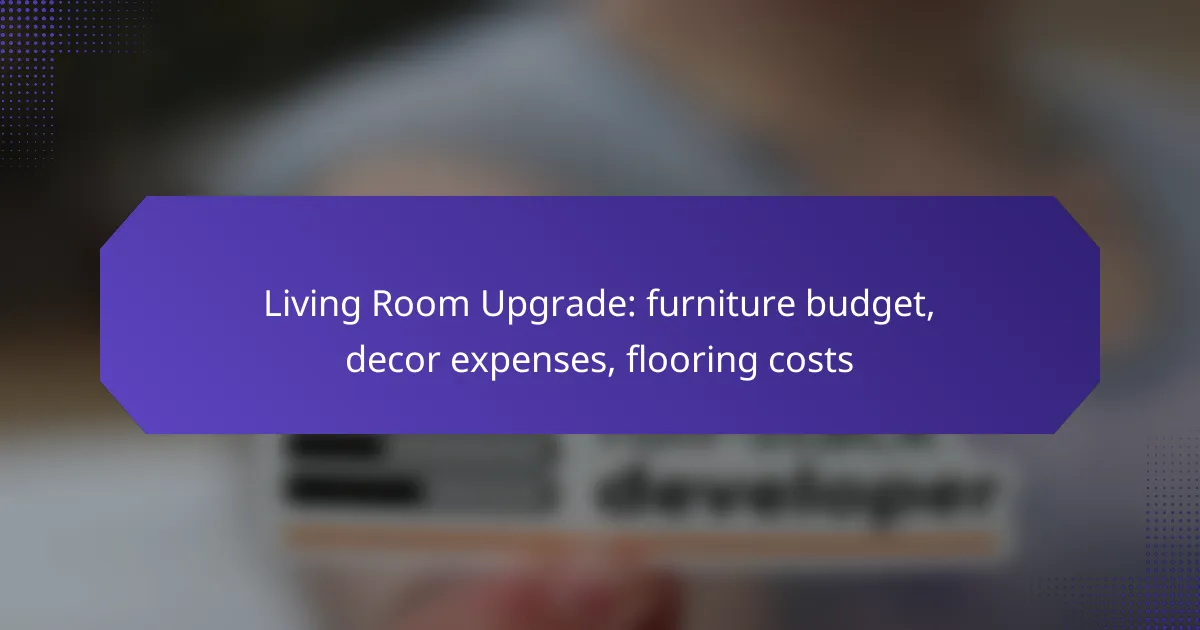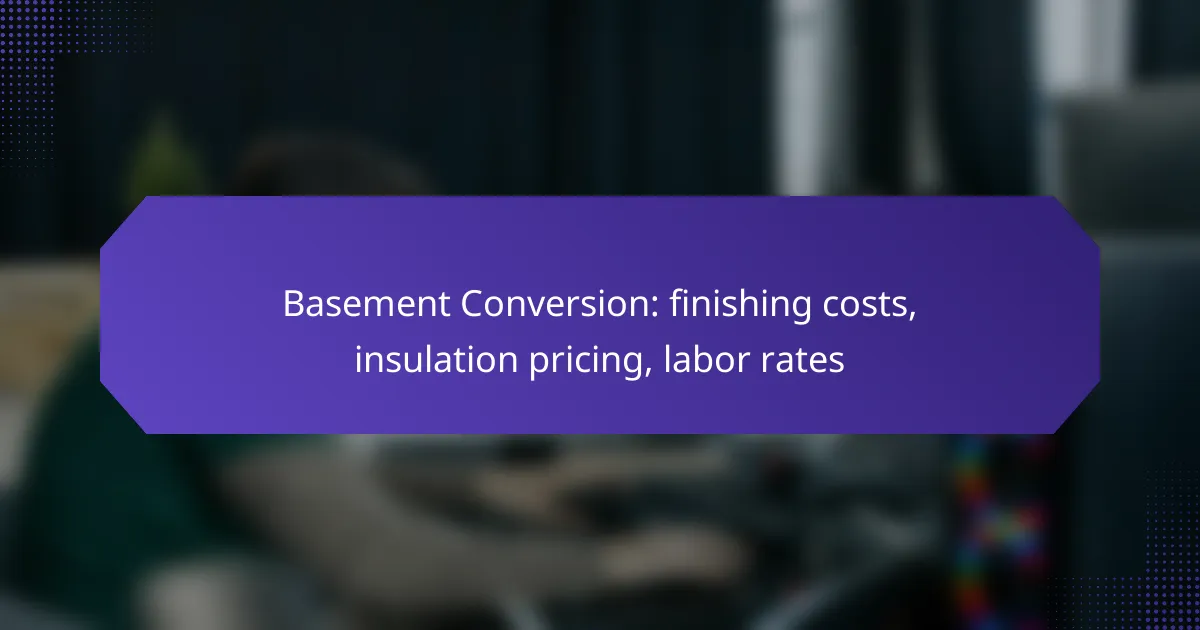Upgrading your living room requires careful budgeting for furniture, decor, and flooring to create a cohesive and inviting space. In Los Angeles, it’s essential to consider local prices and set a realistic spending limit, factoring in quality and style. Additionally, decor expenses can vary greatly, encompassing everything from wall art to rugs, while flooring costs depend on material and installation choices. By understanding these elements, you can effectively plan your living room transformation.

How to budget for living room furniture in Los Angeles?
Budgeting for living room furniture in Los Angeles involves understanding local prices and setting a realistic spending limit. Consider factors like quality, style, and the overall design of your space to create a balanced budget that meets your needs.
Average furniture costs
In Los Angeles, average costs for living room furniture can vary widely based on style and quality. A basic sofa may range from $500 to $2,000, while coffee tables typically cost between $100 and $800. High-end designer pieces can exceed these averages significantly.
Additionally, consider the costs of complementary items such as chairs, entertainment centers, and decor. A complete living room set can range from $2,000 to over $10,000 depending on your choices.
Budgeting tips for furniture
Start by determining your total budget for living room furniture, then allocate specific amounts for each piece. Prioritize essential items like sofas and tables before considering decorative elements.
Look for sales, discounts, and second-hand options to stretch your budget further. Setting aside 10-20% of your total budget for unexpected expenses can also help manage costs effectively.
Popular furniture stores in Los Angeles
Los Angeles offers a variety of furniture stores catering to different styles and budgets. Well-known retailers include IKEA for affordable options, West Elm for modern designs, and Restoration Hardware for luxury pieces.
Local boutiques and thrift stores can also provide unique finds at lower prices. Exploring online marketplaces like Craigslist or Facebook Marketplace can yield great deals on gently used furniture as well.

What are the typical decor expenses for a living room?
Typical decor expenses for a living room can vary widely based on style, quality, and personal preferences. Budgeting for decor often includes costs for wall art, accessories, curtains, rugs, and other decorative elements, which can collectively range from a few hundred to several thousand dollars.
Cost of wall art and accessories
The cost of wall art and accessories can significantly impact your living room budget. Original artwork can range from a few hundred to several thousand dollars, while prints and posters are generally more affordable, often costing between $20 and $200. Accessories like vases, sculptures, and decorative pillows can add another $100 to $500, depending on the quality and brand.
When selecting wall art, consider the size and style that will complement your space. Mixing different types of art and accessories can create a more dynamic look without overspending.
Average prices for curtains and rugs
Curtains and rugs are essential elements that can enhance the overall aesthetic of your living room. Average prices for curtains typically range from $30 to $300 per panel, depending on fabric and design. For rugs, expect to pay between $100 and $1,000, with size and material being the primary factors influencing cost.
When choosing curtains, opt for materials that provide the desired level of light control and privacy. For rugs, consider durability and ease of cleaning, especially in high-traffic areas.
Decorating styles and their costs
Different decorating styles can influence overall costs in your living room. For example, a minimalist style may require fewer pieces, potentially lowering expenses, while a bohemian style could involve a variety of textures and colors, increasing costs. On average, a budget-friendly approach might range from $500 to $2,000, while a more luxurious design could exceed $5,000.
Before committing to a style, consider how it aligns with your existing furniture and decor. Mixing styles can create a unique look but may require additional investment in complementary pieces.

What are the flooring costs for living rooms?
Flooring costs for living rooms can vary significantly based on the material chosen, installation methods, and regional pricing. Understanding these factors helps in budgeting effectively for your living room upgrade.
Average cost of hardwood flooring
The average cost of hardwood flooring typically ranges from $5 to $15 per square foot, depending on the type of wood and finish. Popular choices like oak or maple fall within this range, while exotic woods can be more expensive.
When budgeting, consider additional expenses such as underlayment and finishing, which can add another $1 to $3 per square foot. It’s wise to shop around and compare prices at different retailers to find the best deal.
Cost comparison of carpet vs. tile
Carpet generally costs between $2 and $7 per square foot, making it a more affordable option compared to tile, which can range from $5 to $20 per square foot. While carpet offers warmth and comfort, tile provides durability and ease of maintenance.
When deciding between the two, consider the long-term costs. Tile may have a higher upfront cost but can last significantly longer than carpet, which may require replacement every 5 to 10 years.
Installation costs in Los Angeles
In Los Angeles, installation costs can vary widely, typically ranging from $1 to $5 per square foot, depending on the flooring type and complexity of the job. For example, hardwood installation might be on the higher end due to the skill required.
It’s advisable to obtain multiple quotes from local contractors to ensure competitive pricing. Additionally, check if the installation includes removal of old flooring, as this can impact overall costs significantly.

What factors influence living room upgrade costs?
Several key factors influence the costs associated with upgrading a living room, including the size of the space, the quality of materials used, and local labor costs. Understanding these elements can help you budget effectively and make informed decisions about your renovation project.
Size of the living room
The size of your living room significantly impacts the overall cost of upgrades. Larger spaces typically require more materials, which can increase expenses for flooring, furniture, and decor. For example, upgrading a small living room may cost a few thousand dollars, while a larger area could easily exceed ten thousand dollars.
When planning your budget, consider how the size will affect not only material costs but also the amount of labor needed for installation or assembly. A larger room may require additional time and effort from contractors, which can further drive up costs.
Quality of materials
The quality of materials you choose for your living room upgrade can vary widely in price. High-end materials, such as hardwood flooring or designer furniture, can significantly increase your budget, while more affordable options like laminate or mass-produced furnishings can help you save money. It’s essential to balance quality with your budget to achieve the desired aesthetic.
Consider creating a list of must-have items versus nice-to-have items. Prioritize spending on key features like flooring and furniture while opting for more budget-friendly decor options. This approach allows you to maintain quality where it matters most without overspending.
Labor costs in Los Angeles
Labor costs in Los Angeles can be quite high compared to other regions, affecting your overall living room upgrade expenses. Skilled labor, such as contractors or interior designers, often charges premium rates, which can range from $50 to $150 per hour depending on their expertise and the complexity of the work.
To manage labor costs effectively, consider obtaining multiple quotes from different contractors and negotiating terms. You might also explore DIY options for simpler tasks like painting or assembling furniture to save on labor expenses. However, ensure that you have the necessary skills to avoid costly mistakes.

How to choose the right furniture for your budget?
Choosing the right furniture for your budget involves assessing your needs, prioritizing essential items, and finding quality options within your price range. Start by determining what pieces are necessary for your living space and then explore various retailers to compare prices and materials.
Identifying essential vs. non-essential items
Begin by listing the furniture items you need for your living room. Essentials typically include a sofa, coffee table, and seating options, while non-essentials might be decorative chairs or accent tables. Focus on acquiring the essentials first to ensure your space is functional.
Once you have the essentials, consider your lifestyle and how you use your living room. For instance, if you frequently entertain guests, investing in additional seating may become a priority. Create a hierarchy of needs to guide your purchasing decisions.
Evaluating quality vs. price
When evaluating furniture, balance quality with price to ensure durability without overspending. Look for materials that offer longevity, such as solid wood or high-density foam, rather than cheaper alternatives that may wear out quickly.
Set a budget range for each item, and compare similar products across different retailers. A good rule of thumb is to allocate around 20-30% of your total budget for high-quality pieces that will last, while considering lower-cost options for decorative items.
Shopping during sales events
Take advantage of sales events to maximize your furniture budget. Major holidays like Black Friday, Labor Day, and end-of-season clearances often feature significant discounts on furniture. Planning your purchases around these times can lead to substantial savings.
Additionally, subscribe to newsletters from furniture retailers to receive alerts about upcoming sales and exclusive promotions. This can help you stay informed about price drops and special offers that align with your budgetary goals.

What are the latest trends in living room upgrades?
Current trends in living room upgrades focus on sustainability, multifunctionality, and personalized aesthetics. Homeowners are increasingly opting for eco-friendly materials, versatile furniture, and unique decor that reflects their individual style.
Eco-friendly furniture options
Eco-friendly furniture options are gaining popularity as consumers become more environmentally conscious. These pieces are often made from sustainable materials like reclaimed wood, bamboo, or recycled metals, reducing the carbon footprint associated with traditional furniture production.
When selecting eco-friendly furniture, consider certifications such as FSC (Forest Stewardship Council) or GREENGUARD, which ensure that products meet specific environmental standards. Prices for eco-friendly furniture can vary widely, typically ranging from moderate to high, depending on the materials and craftsmanship.
To make the most of your budget, look for local artisans or second-hand shops that offer sustainable options. This not only supports the local economy but also provides unique pieces that can enhance your living room’s character.










